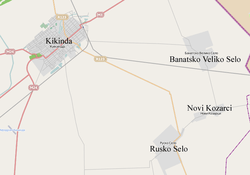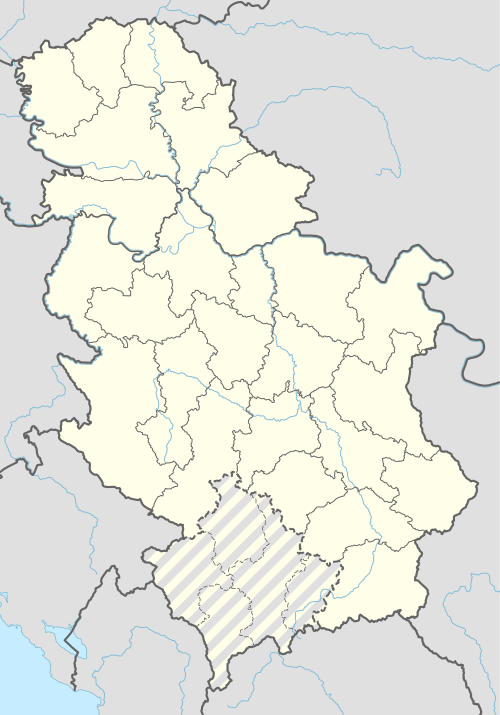Rusko Selo
Rusko Selo (Serbian Cyrillic: Руско Село; Hungarian: Torontáloroszi) is a village in northeastern Serbia, located within the Kikinda municipality, North Banat District, Vojvodina.
Rusko Selo | |
|---|---|
 Map of Rusko Selo and other settlements in the neighborhood | |
 Rusko Selo Location of Rusko Selo within Serbia | |
| Coordinates: 45°45′28″N 20°34′11″E | |
| Country | |
| Province | |
| Region | Banat |
| District | North Banat |
| Municipality | Kikinda |
| Elevation | 71 m (233 ft) |
| Population (2011) | |
| • Rusko Selo | 2,811 |
| Time zone | UTC+1 (CET) |
| • Summer (DST) | UTC+2 (CEST) |
| Postal code | 23314 |
| Area code(s) | +381(0)230 |
| Car plates | KI |
Name
In Serbian the village is known as Rusko Selo (Руско Село), meaning "Russian Village". In German it is known as Ruskodorf, and in Hungarian as Kisorosz or Torontáloroszi.
History
In the Middle Ages, the settlement was known as Oroszi. During Ottoman times, it was populated by Serbs. In 1718, it was incorporated into the Habsburg province of Banat of Temeswar, at which time it was known in Serbian as Mali Orosin. In 1723–25, the place was uninhabited. It was repopulated in 1767 by German colonists, while Hungarian colonists were settled in the village in 1776. In the 19th century, Romanians settled in the village as well. After World War I, a new settlement known as Kolonija or Čarnojevićevo was built near the old village. After World War II, Serb refugees from Bosnia settled in the village.
Culture
- Serbian Orthodox church of the Ascension of Holy Madonna, built in 1797
- Roman Catholic church of St. Peter and Paul, built between 1802 and 1832
- Čarnojević family mausoleum (sr)
 Catholic church
Catholic church Čarnojević family mausoleum
Čarnojević family mausoleum
Demographics
The village has a Serb ethnic majority and a population of 2,811 (2011 census).
In 2002 village had population of 3,328 and ethnic groups in the village were: Serbs (1,880) or 56.49%, Hungarians (1,181) or 35.48%, Yugoslavs (55), Roma (48), Montenegrins (43), Croats (18), Ukrainians (12), etc.[1]
- Historical population
- 1948: 4,294
- 1953: 4,341
- 1961: 4,143
- 1971: 3,830
- 1981: 3,657
- 1991: 3,510
- 2002: 3,328
See also
- List of places in Serbia
- List of cities, towns and villages in Vojvodina
References
- Slobodan Ćurčić, Broj stanovnika Vojvodine, Novi Sad, 1996.
External links
| Wikimedia Commons has media related to Rusko Selo. |
- Elementary school – official page
- Interesting news (In Serbian)
- Economy news (In Serbian)
- Ethno-news (In Serbian)
- Criminal news (In Serbian)